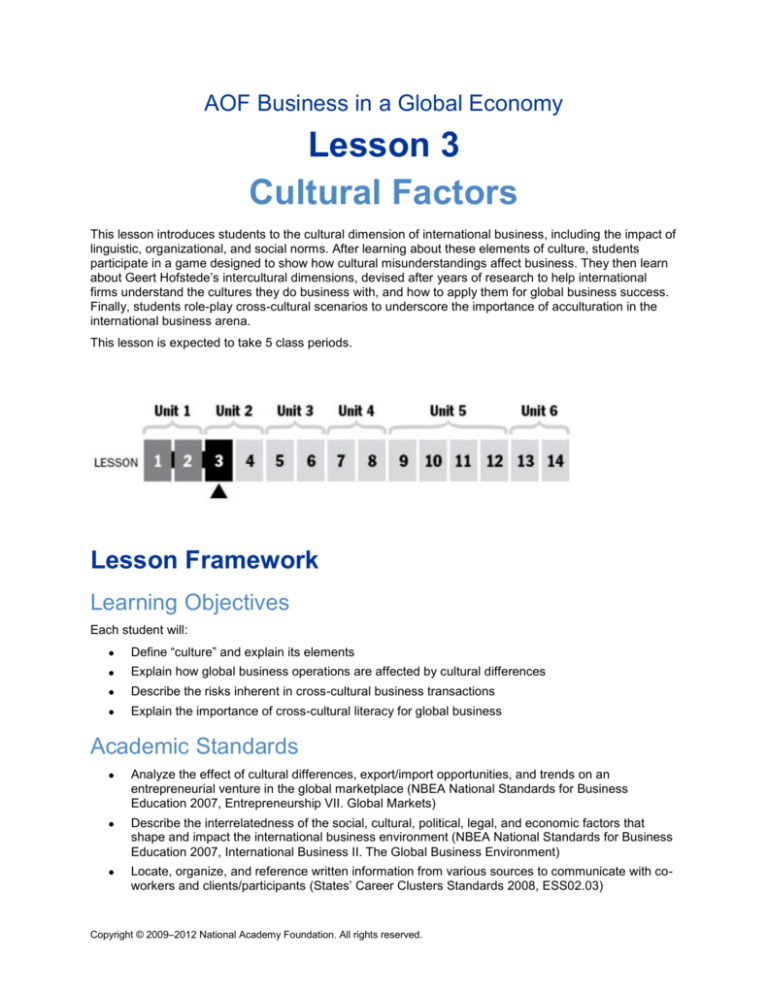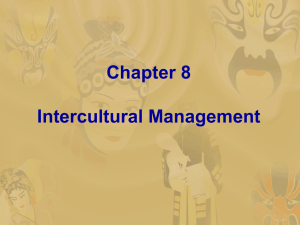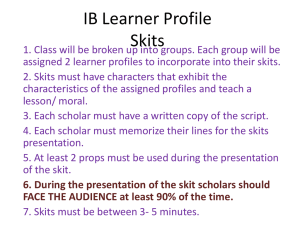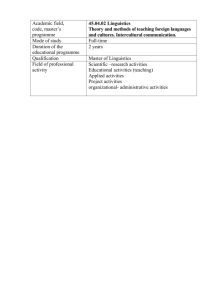
AOF Business in a Global Economy
Lesson 3
Cultural Factors
This lesson introduces students to the cultural dimension of international business, including the impact of
linguistic, organizational, and social norms. After learning about these elements of culture, students
participate in a game designed to show how cultural misunderstandings affect business. They then learn
about Geert Hofstede’s intercultural dimensions, devised after years of research to help international
firms understand the cultures they do business with, and how to apply them for global business success.
Finally, students role-play cross-cultural scenarios to underscore the importance of acculturation in the
international business arena.
This lesson is expected to take 5 class periods.
Lesson Framework
Learning Objectives
Each student will:
Define “culture” and explain its elements
Explain how global business operations are affected by cultural differences
Describe the risks inherent in cross-cultural business transactions
Explain the importance of cross-cultural literacy for global business
Academic Standards
Analyze the effect of cultural differences, export/import opportunities, and trends on an
entrepreneurial venture in the global marketplace (NBEA National Standards for Business
Education 2007, Entrepreneurship VII. Global Markets)
Describe the interrelatedness of the social, cultural, political, legal, and economic factors that
shape and impact the international business environment (NBEA National Standards for Business
Education 2007, International Business II. The Global Business Environment)
Locate, organize, and reference written information from various sources to communicate with coworkers and clients/participants (States’ Career Clusters Standards 2008, ESS02.03)
Copyright © 2009–2012 National Academy Foundation. All rights reserved.
AOF Business in a Global Economy
Lesson 3 Cultural Factors
Interpret verbal and nonverbal cues/behaviors to enhance communication with co-workers and
clients/participants (States’ Career Clusters Standards 2008, ESS02.07)
Employ critical thinking skills independently and in teams to solve problems and make decisions
(e.g., analyze, synthesize and evaluate) (States’ Career Clusters Standards 2008, ESS03.01)
Assessment
Assessment Product
Means of Assessment
Skit written and performed to illustrate culture
clash (Student Resource 3.6)
Assessment Criteria: Culture Clash Skit
(Teacher Resource 3.4)
Prerequisites
Understanding of the forces that contribute to globalization
Familiarity with basic American business etiquette
Ability to reflect on American cultural norms
Ability to identify geographic locations based on cultural clues
Instructional Materials
Teacher Resources
Teacher Resource 3.1, Presentation and Notes: The Elements of Culture (includes separate
PowerPoint file)
Teacher Resource 3.2, Guide: Global Culture Game
Teacher Resource 3.3, Guide: Guess the Country
Teacher Resource 3.4, Assessment Criteria: Culture Clash Skit
Teacher Resource 3.5, Key Vocabulary: Cultural Factors
Teacher Resource 3.6, Bibliography: Cultural Factors
Student Resources
Student Resource 3.1, Worksheet: Restaurant Menu Puzzle
Student Resource 3.2, Reading: The Elements of Culture
Student Resource 3.3, Reading: Intercultural Dimensions
Student Resource 3.4, Deduction: Guess the Country
Student Resource 3.5, Chart: Cultural Norms
Student Resource 3.6, Instructions: Culture Clash Skit
Copyright © 2009–2012 National Academy Foundation. All rights reserved.
-2-
AOF Business in a Global Economy
Lesson 3 Cultural Factors
Equipment and Supplies
LCD projector and computer for PowerPoint presentation
Internet-enabled computers (at least one for every two or three students)
Sufficient space for mock party game play and skit presentations
Blackboard, whiteboard, or chart paper
Lesson Steps
Step
Min.
Activity
CLASS PERIOD 1
1
25
Think-Group-Share: Restaurant Menu Puzzle
By looking at and thinking about the different menu items offered in various countries by
the same restaurant franchise, students will get an introduction to the importance of an
organization’s ability to adapt based on culture. This menu provides students with an
example they can relate to, preparing them to apply what they learn about culture to
business scenarios later in the lesson.
Without telling students that the menus are from the same franchise, refer them to
Student Resource 3.1, Worksheet: Restaurant Menu Puzzle. Explain that each menu
describes a common meal offered by restaurants in four different countries. Ask
students to begin the activity by individually reading the four menus and guessing which
country each menu is from. Instruct them to write down on the worksheet their guesses
and what clues led them to these guesses.
Next, ask students to form groups of three or four and share their answers with one
another. Explain that they should discuss their reasoning and come up with a
consensus for all four menus. Once each group is in agreement, reveal the countries
from which each menu comes. (The answers in order are Japan, France, India, and
Israel). Ask students to share what clues they found in each menu that led them to their
answers.
Finally, ask students to imagine what the restaurants these menus are from are like.
Ask for students’ ideas before revealing that these menus are all from the same
restaurantMcDonald’s! Invite students to share why they think restaurants create
menus specific to countries, emphasizing that cultural norms vary across the world, and
that these norms include food. This will prepare them for the next activity, in which they
will learn about the elements of culture.
2
25
Presentation: The Elements of Culture
The objective of this activity is to provide students with a more in-depth understanding
of the three elements of culture: organizational, linguistic, and social. It will also get
them thinking about how and why businesses expanding globally must learn about and
respect the local culture in order to be successful.
Before class begins, prepare notes to guide class discussion using Teacher Resource
Copyright © 2009–2012 National Academy Foundation. All rights reserved.
-3-
AOF Business in a Global Economy
Lesson 3 Cultural Factors
Step
Min.
Activity
3.1, Presentation Notes: The Elements of Culture.
Instruct students to take notes on the presentation by using the “thinking in 1-2-3” notetaking strategy, in which they write down:
1 question they have
2 things they found interesting
3 important facts or ideas they learned
Present Teacher Resource 3.1, Presentation: The Elements of Culture (separate
PowerPoint file) to the class. There are various options for using this presentation with
your students, depending upon your situation and preferences:
1. This teacher resource can be presented as a PowerPoint slideshow using an LCD
projector. To activate the slideshow, click View and select Slide Show. Every time
you click the mouse, the next slide will appear.
Use the presentation notes you prepared prior to class to introduce the content of
each slide and encourage class discussion. Note that this activity is not a lecture
but rather a participatory experience for the students; the presentation is interactive
and designed to provoke inquiry.
2. This complete presentation is also included for students to use as Student
Resource 3.2, Reading: The Elements of Culture. You can have them read it and
answer the discussion questions in their notebooks, and then come together as a
class to share ideas for the answers.
No matter which approach you take with this teacher resource, keep in mind that the
presentation is interactive and designed to provoke inquiry. Many of the slides contain a
discussion question to explore with your students.
Students can pair up and share their notes after the presentation. You may also wish to
have them answer the discussion questions on each slide in their notebooks, or aloud,
depending on your preference and the time available.
After the presentation, explain to students that they will be playing a cultural game in
the next class period that will give them more insight into the need for cross-cultural
understanding.
CLASS PERIOD 2
3
50
Game: Global Cultures
This activity teaches students cross-cultural awareness and how perceptions and
misperceptions affect our feelings about others.
Explain to students that they will be playing a game in which each member of the class
will belong to one of two cultures. The purpose of the game is to interact with members
of the other culture to glean information about their culture by observing their behavior.
They will then get a chance to share and correct their observations. For specific
instructions on how to conduct the Global Culture Game, see Teacher Resource 3.2,
Guide: Global Culture Game. Feel free to modify the logistics of the game to suit your
classroom.
Copyright © 2009–2012 National Academy Foundation. All rights reserved.
-4-
AOF Business in a Global Economy
Lesson 3 Cultural Factors
Step
Min.
Activity
After breaking the class into two groups, allow each a few minutes to read their
culture’s norms and practice behaving that way. Begin the “party” and ask students to
interact, attempting to glean information from members of the other culture. After 10–15
minutes, stop the party and ask students to record their impressions of the other
culture. If there’s time, begin the party again, allowing students a chance to gather more
information. Next, have the two members share their impressions before allowing each
side to explicate its cultural norms. Conclude by sharing your observations and
emphasizing that cultural misunderstandings can impede relationships, including
professional ones.
Explain that in the next activity, students will discover how many business people learn
to relate effectively with people of other cultures using Geert Hofstede’s Intercultural
Dimensions scale.
CLASS PERIOD 3
4
25
Reading: Intercultural Dimensions
This activity introduces students to Geert Hofstede’s Intercultural Dimensions scale,
which rates cultures on their Power Distance, Individualism, Uncertainty Avoidance,
and Masculinity.
Invite students to think about one important piece of cultural information a
businessperson would need to understand before doing business in another country.
Ask them to share their answers with you or a partner. Explain that Geert Hofstede is a
researcher who has created a scale, called Intercultural Dimensions, that help
international business people to gain understanding of the cultures with which they
door would like to dobusiness.
Refer students to Student Resource 3.3, Reading: Intercultural Dimensions. Ask them
to read the descriptions of each dimension. Explain that these are simplified versions of
the intercultural dimensions Hofstede researched, but that they apply to the people, and
the cultures they come from generally. Check for understanding by probing students’
reactions to the examples and ratings discussed in the reading. Answer any questions
and clarify any points. Finally, ask students to pair up and discuss the questions on the
reading that appear at the end of each section. Call on students to share their answers.
Let students know that now that they have a basic grasp of the dimensions, they will
work with a partner in the next activity to match countries with Hofstede’s Intercultural
Dimensions ratings.
5
25
Matching: Doing Business in Various Countries
This activity gives students the opportunity to put their comprehension of Hofstede’s
Intercultural Dimensions to the test by matching countries with their intercultural
dimension ratings.
Ask students to take out Student Resource 3.4, Deduction: Guess the Country. Instruct
them to pair up and read the short country descriptions and the intercultural dimensions
ratings. After each pair has had a chance to make a guess at matching the countries
with the ratings, reveal the correct answers as explained on Teacher Resource 3.3,
Guide: Guess the Country. Provide appropriate background information as you see fit.
Copyright © 2009–2012 National Academy Foundation. All rights reserved.
-5-
AOF Business in a Global Economy
Lesson 3 Cultural Factors
Step
Min.
Activity
You may find it helpful to mark the assignment for credit/no credit.
Explain that now that students understand the importance of cultural knowledge for
international business success, they will have a chance to practice their skills by writing
and participating in acculturation scenarios.
CLASS PERIOD 4
6
25
Research: Cultural Norms
This activity gives students a chance to research the cultural norms of a country they
have interest in.
Refer students to Student Resource 3.5, Chart: Cultural Norms. Read the first two
columns about the United States’ cultural norms to the class and clarify any necessary
points. Next, break students into groups of two or three and ask them to research the
cultural norms of a country in which an American company wants to conduct business.
Each group should investigate the norms of a different country and complete the third
column of the chart. You may wish to mention that in some countries there’s more than
one significantly different culture, sometimes (but not always) in different geographic
regions. It’s often very important to know which one you’re dealing with.
The student resource provides two different websites students can use to complete
their research. If Internet access is unavailable, print out relevant websites and provide
applicable newspapers, magazines, books, and so on for students to use as reference
for the scenarios. Circulate and assist students as necessary. You may wish to assign
this research as homework.
Explain that now that students have researched the norms of a country, they will share
their newfound knowledge with their peers by writing and performing a short skit about
it in the next activity.
7
25
Skit Writing: International Business Culture Clashes
This activity allows students to build upon their cultural research by creating a scenario
that exhibits a culture clash. It focuses on the following career skills:
Demonstrating teamwork and cooperation
Framing, analyzing, and solving difficult problems
Ask students to continue to work with their research groups for this activity. Refer them
to Student Resource 3.6, Instructions: Culture Clash Skit, which provides instructions
for the skit. Instruct them to read through the instructions and the criteria for
assessment with their group members. Answer any questions they have.
Explain that they will be using their research to write a short skit that portrays a culture
clash between two businesses, one in the United States and the other in country they
researched. This skit should show a typical business interaction between two members
of different cultures during which a conflict, caused by differences in the two cultures’
norms, arises. The student resource provides an example about South Korea.
Encourage students to be creative, but realistic, when composing their skits, working to
come up with a possible resolution for the culture clash that encourages cross-cultural
Copyright © 2009–2012 National Academy Foundation. All rights reserved.
-6-
AOF Business in a Global Economy
Lesson 3 Cultural Factors
Step
Min.
Activity
understanding. Remind them to avoid negative stereotyping, such as “funny” accents,
when creating their skits. Circulate among groups as they write, and remind them to
use Student Resource 3.6, Instructions: Culture Clash Skit, to guide them. Once they
have completed the skits, ask them to practice. They may wish to practice for
homework, since they will have only a few minutes to practice before performing for
their peers in the next class period. Alternatively, you may wish to build another class
period into this lesson for the skits if time permits.
CLASS PERIOD 5
8
10
Skits: Practice
This activity allows students to rehearse their culture clash skits before they share them
with their peers.
Ask students to join with their groups and rehearse their skits one last time, working out
any kinks before they present them in the next activity.
9
30
Skits: Becoming Acculturated for Business Success
This activity allows students to see their peers perform international business culture
clash scenarios and their possible solutions and form opinions on the solutions. It
focuses on the following career skills:
Being open and responsive to new and diverse perspectives
Articulating disagreement in a courteous and constructive manner
Ask students to act out their skits in front of the other groups, After each group
performs, ask students to identify the culture clash. If time permits, solicit alternative
solutions for each scenario from the class.
Explain to students that they should think about the most important things they learned
in the lesson for the next and final activity, in which they will write international business
success tips. Assess the skits, using each group’s written version as helpful, with
Teacher Resource 3.4, Assessment Criteria: Culture Clash Skit.
10
10
Reflection: Tips for Business Success
In this activity, students synthesize newly learned information about the importance of
cultural sensitivity in international business.
Explain to students that they will be creating a list of the top tips for international firms to
know about dealing successfully with other cultures. Emphasize that these tips should
apply to all cultures rather than be culture-specific, and model an example, such as
“Make sure to understand the education and skills of the workforce in the country in
which you would like to expand so you can find the right workforce,” NOT “In Japan
white is the color of mourning, so be aware not to present white flowers for any
occasion but a death” to show the difference.
Ask students to share the tip they felt was most important and record the tips on the
blackboard, whiteboard, or chart paper. Let students know that they will next learn
Copyright © 2009–2012 National Academy Foundation. All rights reserved.
-7-
AOF Business in a Global Economy
Lesson 3 Cultural Factors
Step
Min.
Activity
about the political and economic factors that affect global business.
Extensions
Enrichment
Build on students’ understanding of Hofstede’s Intercultural Dimensions by asking students to
create new cultures and rate these cultures according to Hofstede’s Intercultural Dimensions.
Examples could include “Kansas City Teens” or “freshmen at this school.” Have them share their
findings and make a chart of all the new cultures to display in the classroom.
Delve even further into Hofstede’s Intercultural Dimensions by assigning students to research one
country and prepare a pamphlet for a US business wishing to expand there. The pamphlet should
include aspects of the four dimensions and what the American businesspeople should know about
doing business there to ensure success as well as explanatory text and helpful images.
To share the knowledge that students have obtained in the reflection activity, ask them to publish
their tips online or in print. For more in-depth coverage of cultural factors, break students into
regional groups and research and write tips specific to these areas. Share these tips with NAF
academy advisory board members, other NAF schools, and so on.
In order to reinforce the concept that traffic signs give universal information, ask students to take
one cultural faux pas and make a traffic sign about it that will hang in the classroom. Have
students research and use universal symbols for their signs, including symbols of color and shape,
for their signs. Post signs in the classroom.
To put a face on globalization, ask student to look at her own family, or a friend’s family, for the
influence of globalization. Have students create globalization family trees that connect ancestors
with a globalization event and how it affected them.
To learn more about cross-cultural norms, read the travel tips at http://travel.yahoo.com/pinterests-25465358. Ask students to work in teams to add another tip to the list.
Cross-Curricular Integration
English/Language Arts/Drama: Ask students to flesh out the culture clash scenarios they wrote
into short plays. Ensure that they research the countries represented in the scripts before writing
detailed scripts that include appropriate verbal and nonverbal language. Once students have
written the scripts, have them gather costumes and create sets. If possible, perform these skits for
other NAF students and/or NAF academy advisory board members. Ask representatives from
each group to answer questions from the audience about their skit.
Math: Have students choose a region of the world and gather Hofstede’s Intercultural Dimension
ratings for all the countries in that region. Average all the ratings of the countries and create a
document with each regional score and what assumptions we can make about it based on the
ratings.
Copyright © 2009–2012 National Academy Foundation. All rights reserved.
-8-







